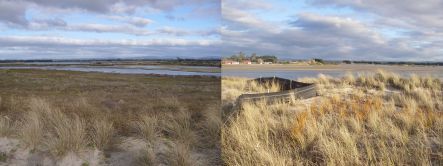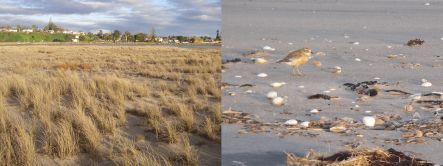By Alison Ballance

Looking from Maketu Spit towards lower Kaituna River and the Maketu-Ongatoro estuary (left), and one of the trapping fences crossing the spit, with golden pingao visible amongst the spinifex (images: A. Ballance)
Last week on Our Changing World we heard from Loder Cup winner Mark Dean and from Harley Spence about why sand dunes matter, and the work of the Dune Restoration Trust. This week we’re off to the Bay of Plenty, to see a project that won the Trust’s Best Coastal Dune Restoration Award in 2011.
The Maketu Ongatoro Wetland Society were also the Supreme Winner in the 2011 Western Bay of Plenty Community Awards for their work on Maketu Spit, just south-east of Te Puke.
On a fine winter day Alison Ballance joins local resident and Society member Julian Fitter for a walk along the 3.5. kilometre-long spit, which is an ecologically significant dune-wetland ecosystem. The Society has a 5-year biodiversity restoration plan, which involves trialling plantings of different species on the back dunes, removing weedy species such as pines, marram grass and tree lupins, and trapping introduced mammals such as hedgehogs and rats. An invertebrate survey found five undescribed species on the spit, and there are good numbers of skinks present. The end of the spit, nearest the village of Maketu, is an important breeding site for about 12 pairs of the endangered New Zealand dotterel.

The New Zealand dotterel breeding area on the Maketu Spit, near the village of Maketu (left) and a New Zealand dotterel feeding on the beach (images: A. Ballance)

